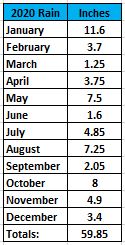Then Isaac sowed in that land, and received in the same year an hundredfold: and the Lord blessed him. Genesis 26:12
There are many verses in Scripture, particularly in the Gospels about the Parable of the Sower, in which the Lord talks about sowing and the multiplication of the seed, resulting in harvests of a hundredfold. That's a great yield! This year, we are going to track our harvest in our potato crop. I've always enjoyed growing potatoes. I can remember Irish Potatoes was the first thing my grandpa taught me to plant when I was a young boy. Those are good memories about gardening that I still think about forty-something years later as I put in a garden each year.
I asked my wife to check out our local feed store for Seed Potatoes. We generally plant the LaSoda variety. The LaSoda is a red potato. This variety was developed in 1948 by Louisiana State University Ag Experiment Station. It is suited for our soils, climate and growing conditions.
Finally, Tricia texted me at work to let me know that seed potatoes were in. You can see that we purchased 6 pounds of potatoes. They were priced at $0.50 per pound or $3.00. We have a whopping 10% sales tax in our parish, so after rendering to Ceasar what is Ceasar's, Tricia exited the feed store.
I examined each potato for quality and all appeared to be good. You can see right above my thumb in the photo below is one of the eyes of the potato. My science teacher in high school, Stuart Buck, used to jokingly tell us that we should plant our potatoes wrapped in a newspaper so they'd have something to read while in the ground. However, most newspapers today aren't worth wrapping fish in or lining a birdcage with , but that's neither here nor there and I digress.
Now you can plant the entire potato, OR you can cut the potato in pieces, ensuring that you have at least one eye in every potato chunk. That's what I always do. Each eye grows a nice potato plant. I use a sharp knife to cut the potatoes up and then I turn them so that the cut side faces upward. Then I place the potatoes inside in the warmest place I can find. This will allow the cut part of the potato to 'scab' over. I am told that if you immediately plant them without allowing them to scab, then the potatoes would rot in the ground.
I generally try to plant the spuds on or as close as possible to February 14th - Valentine's Day (since we love potatoes). We'll see if the weather is cooperative. They will mature in 110 to 120 days. We know that we will put 6 pounds of potatoes in the ground. A hundred-fold yield seems like a tall order! We will track our harvest, though, and weigh it and report back our yield in early summer.

















































